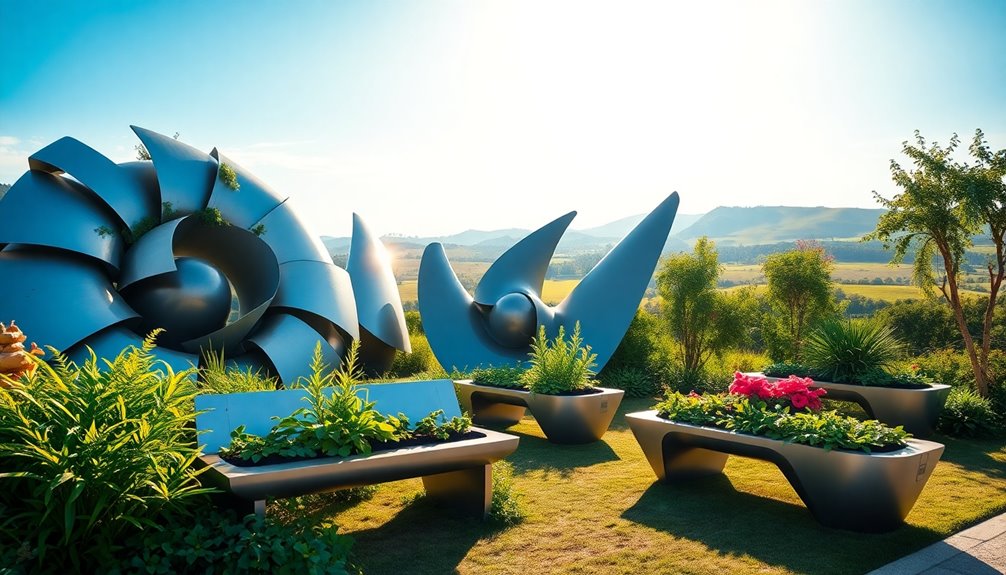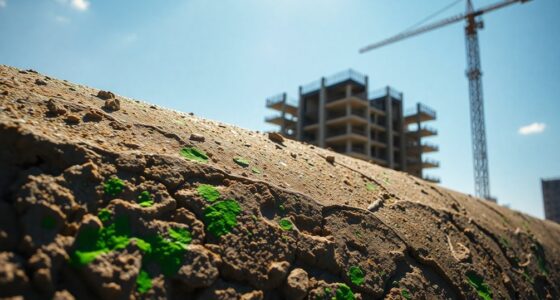You can give new life to decommissioned turbine blades by repurposing them through circular economy practices. These large, reinforced fiberglass structures can be transformed into valuable infrastructure components, reducing reliance on raw materials and cutting costs significantly. By recycling and reusing materials, you help lower greenhouse gas emissions and conserve resources. This innovative approach not only stimulates job creation but also aligns with global sustainability goals. Discover how further innovations are shaping the future of turbine blade management.
Key Takeaways
- Repurposing decommissioned turbine blades for infrastructure projects reduces raw material costs and conserves valuable resources.
- Innovations like the DecomBlades project aim to recycle glass fibers for creating new turbine blades.
- Circular economy practices in blade repurposing can significantly lower greenhouse gas emissions and support net-zero goals.
- Job creation opportunities arise in the recycling and construction sectors through the sustainable use of decommissioned blades.
- Developing thermoplastic composite blades enhances recyclability and promotes long-term sustainability in the wind energy industry.

As wind energy continues to grow, the challenge of managing decommissioned turbine blades becomes increasingly pressing. These blades, primarily made of reinforced fiberglass composite, pose significant recycling difficulties due to their complex material composition. Their large size and strength, designed to withstand extreme weather, complicate recycling efforts even further. Currently, methods like cutting and burying or burning blades contribute to greenhouse gas emissions and pollution, highlighting the urgency for sustainable solutions.
The good news is that circular economy approaches are emerging to tackle this problem. One promising solution involves repurposing decommissioned blades as structural components in infrastructure projects, such as highway overhead sign structures. This not only offers economic benefits but also reduces the demand for raw materials. Innovations like the DecomBlades project focus on retrieving glass fibers for reuse in new blades, showcasing the potential for industrial-level recycling. In fact, research has shown that repurposing DWTBs can lead to a 73% reduction in raw material costs for these infrastructure projects. Additionally, these solutions can drive job creation in the recycling and construction sectors.
Furthermore, the development of thermoplastic composite blades aims to enhance recyclability and reduce costs, thereby supporting circular economy initiatives. Repurposing blades can lead to significant cost savings, with reductions of up to 73% for materials used in infrastructure projects. By reusing existing materials, you decrease the demand for new raw materials like steel and concrete, conserving valuable resources.
Moreover, as industries develop recycling technologies and repurposing practices, they can create jobs and stimulate economic growth, extending the life cycle of turbine blades and reducing waste. The environmental benefits are equally compelling. Repurposing blades can significantly reduce CO2 emissions, aligning with global net-zero carbon goals.
Frequently Asked Questions
What Materials Are Turbine Blades Typically Made From?
Turbine blades are typically made from materials like carbon fibers, fiberglass, and balsa wood, which provide strength and lightweight properties.
You'll also find resins such as epoxy, polyester, and vinylester forming the matrices that hold these composites together.
The blades feature a sandwich structure, often incorporating foam or balsa wood cores for added durability.
Understanding these materials is crucial, especially given their role in the efficiency and longevity of wind energy systems.
How Long Do Turbine Blades Usually Last Before Decommissioning?
Ever wondered how long turbine blades can keep spinning? Typically, they last between 20 to 25 years, thanks to their durable fiberglass and composite materials.
However, factors like leading edge erosion from harsh weather can shorten their lifespan. By conducting regular maintenance and inspections, you can help extend their operational life.
What Are the Environmental Impacts of Turbine Blade Disposal?
When you consider the environmental impacts of turbine blade disposal, you'll see significant concerns.
Most blades end up in landfills, which, while cost-effective, create long-term space issues. Incineration, common in the EU, releases greenhouse gases and pollutants.
Repurposing blades can help, turning them into structures like playgrounds, but current methods still contribute to waste.
As the industry grows, addressing these disposal methods becomes crucial for a sustainable future.
Can Turbine Blades Be Recycled Into New Energy Products?
Yes, you can recycle turbine blades into new energy products.
By employing methods like pyrolysis, you can break down the fiberglass and generate energy.
Mechanical grinding allows you to create fillers for various applications, while solvolysis can separate polymers for reuse.
These processes not only reduce waste but also contribute to sustainable practices in the energy sector.
What Are the Economic Benefits of Repurposing Decommissioned Turbine Blades?
Repurposing decommissioned turbine blades brings bountiful benefits.
You'll see significant revenue generation from recycling valuable materials like fiberglass, while creating countless jobs in innovative recycling facilities.
Plus, you'll cut disposal costs, easing financial burdens on industries.
By developing new markets for composite materials, you'll unlock increased material value.
Ultimately, these economic advantages promote sustainability and boost the circular economy, paving the way for a greener, more profitable future.
Conclusion
So, let's toss those old turbine blades into the landfill, right? Who needs circular economy practices when we can just keep digging holes and filling them up? It's not like repurposing them could create jobs, reduce waste, or spark innovation. Nah, let's stick to our outdated ways and pretend we're not drowning in our own refuse. After all, who needs a sustainable future when we've got a perfectly good pile of discarded blades to admire?









